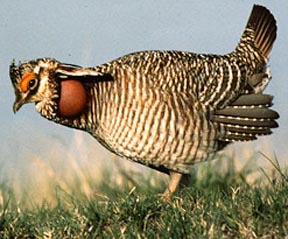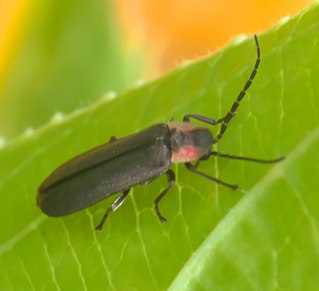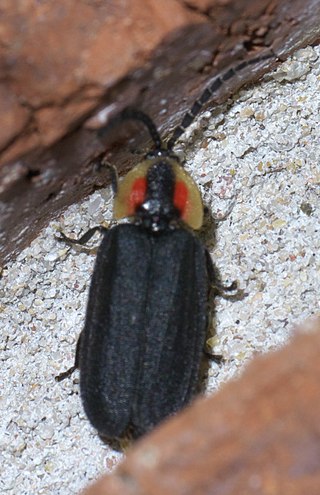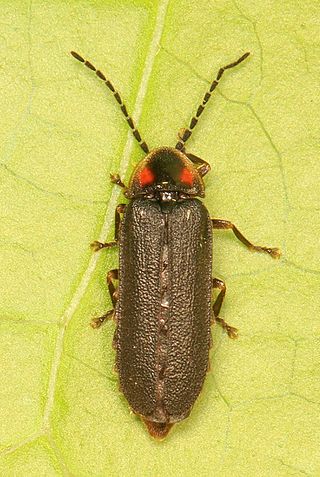
The Lampyridae are a family of elateroid beetles with more than 2,000 described species, many of which are light-emitting. They are soft-bodied beetles commonly called fireflies, lightning bugs, or glowworms for their conspicuous production of light, mainly during twilight, to attract mates. Light production in the Lampyridae is thought to have originated as an honest warning signal that the larvae were distasteful; this was co-opted in evolution as a mating signal in the adults. In a further development, female fireflies of the genus Photuris mimic the flash pattern of Photinus species to trap their males as prey.

The mimids are the New World family of passerine birds, Mimidae, that includes thrashers, mockingbirds, tremblers, and the New World catbirds. As their name suggests, these birds are notable for their vocalization, especially some species' remarkable ability to mimic a wide variety of birds and other sounds heard outdoors. They are commonly referred to as mimic thrushes but are not, in fact, thrushes.

The frogmouths (Podargidae) are a group of nocturnal birds related to owlet-nightjars, swifts, and hummingbirds. Species in the group are distributed in the Indomalayan and Australasian realms.

Photuris is a genus of fireflies. These are the femme fatale lightning bugs of North America. This common name refers to a behavior of the adult females of these predatory beetles; they engage in aggressive mimicry, imitating the light signals of other firefly species' females to attract, kill, and eat the males. Their flashing bioluminescent signals seem to have evolved independently and eventually adapted to those of their prey, mainly unrelated Lampyrinae, such as Photinus or Pyractomena.

Tympanuchus is a small genus of birds in the grouse family. They are commonly referred to as prairie chickens.

Jacana is the genus comprising the two jacanas of the Americas: the northern jacana, and the wattled jacana.

Pyropyga is a genus of primarily North American fireflies in the beetle family Lampyridae. There are about 13 described species in Pyropyga. It is among the genera of Lampyridae where both sexes of adults have no bioluminescent organs.
Micronaspis is a genus of fireflies in the family of beetles known as Lampyridae, containing only one species, the Florida intertidal firefly. It is found in the Bahamas and Florida. It is threatened by habitat loss from coastal development as well as storm surges and sea level rise as a consequence of climate change, with Hurricane Dorian having a major impact on Grand Bahama island, where the species is known from. Increased chemical and light pollution has also seriously affected the species. Further threatening it in Florida is the introduction of Steinernema carpocapsae as a biocontrol agent for crops, which is known to target other beetle species than the ones it is meant to control; it is likely the cause of a local extirpation of a population of M. floridana from Sarasota Bay.

Lucidota atra, the black firefly or woodland lucy, is a diurnal species of firefly — a member of the Lampyridae family of beetles.
Photuris fairchildi is a species of firefly in the beetle family Lampyridae. It is found in North America.This species is known to use aggressive mimicry in order to lure in and prey upon the males of other species of fireflies. This species inhabits marshes, spruce forests, and other low-lying swampy areas.
Prolutacea is a genus of fireflies in the family of beetles known as Lampyridae, containing a single described species, Prolutacea pulsator.

Pyractomena angulata is a species of firefly in the family of beetles known as Lampyridae. It is found in North America and is the state insect of Indiana. It is also known as Say's firefly named after Thomas Say, and the angle candled firefly.
Nelsonphotus is a genus of fireflies in the family of beetles known as Lampyridae, containing a single described species, Nelsonphotus aridus.
Tenaspis is a genus of fireflies in the beetle family Lampyridae. There are about 18 described species in Tenaspis.

Lucidota punctata is a species of firefly in the beetle family Lampyridae. It is found in North America.
Bicellonycha wickershamorum is a species of firefly in the beetle family Lampyridae. It is found in North America.
Bicellonycha is a genus of fireflies in the beetle family Lampyridae. There are more than 40 described species in Bicellonycha.
Lucidota luteicollis is a species of firefly in the beetle family Lampyridae. It is found in North America.
Pterotus is a genus of fireflies in the beetle family Lampyridae. There are at least two described species in Pterotus.
Pollaclasis is a genus of fireflies in the beetle family Lampyridae. There is one described species in Pollaclasis, P. bifaria. Pollaclasis is most closely related to Pterotus, and may someday become included within the Pterotinae subfamily.









